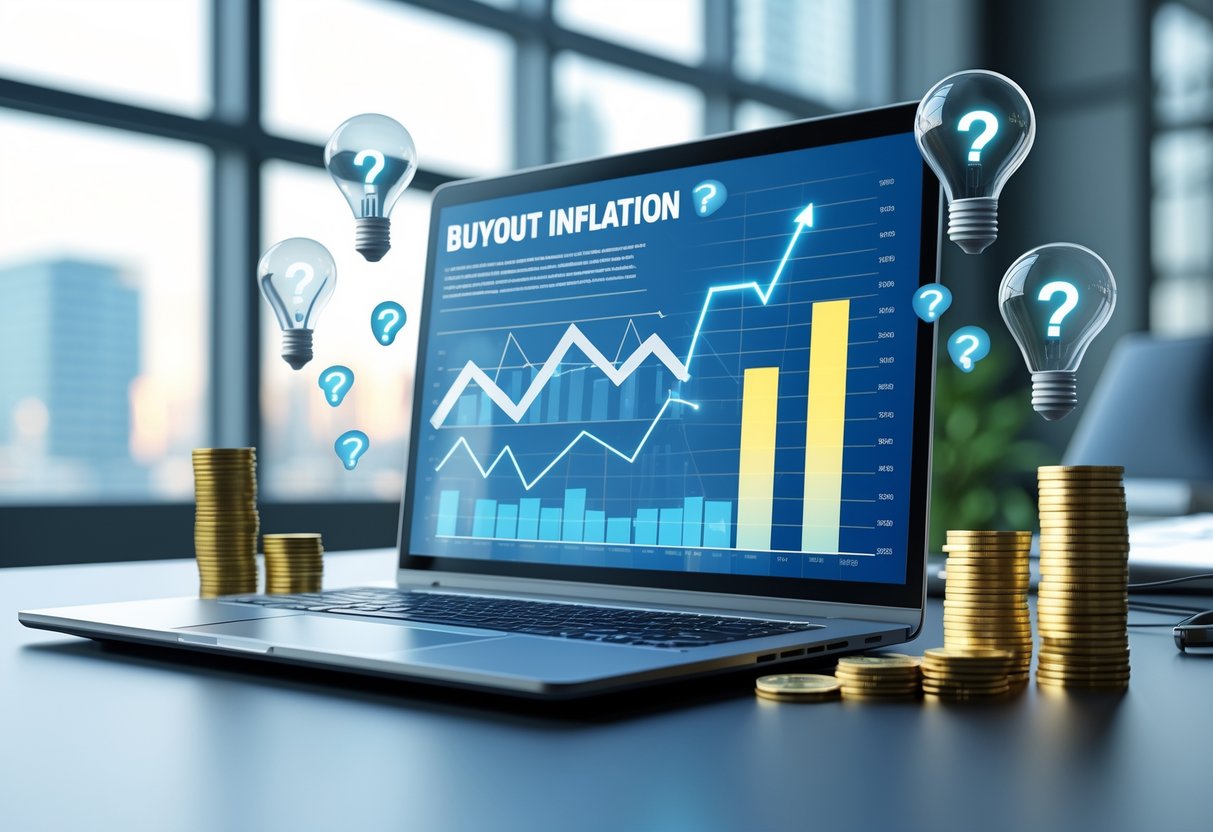Buyout Inflation: Strategies, Risks, and Opportunities in 2025
Updated On: November 13, 2025 by Aaron Connolly
Understanding Buyout Inflation
Buyout inflation pops up when rising prices push up the costs of acquiring companies and shrink their future cash flows.
Private equity firms feel a double whammy—they pay more upfront and expect less in return.
Defining Buyout Inflation
Buyout inflation means private equity firms face steeper costs when buying companies during inflationary periods.
This hits both the initial purchase price and the ongoing costs of running those businesses.
When inflation climbs, companies see higher bills for materials, labor, and general operations.
These new expenses eat into profit margins and cut down cash flows.
At the same time, central banks usually hike interest rates to fight inflation, so borrowing money to fund acquisitions gets a lot pricier.
So, private equity firms end up squeezed from both ends.
They pay more to buy companies but have to settle for lower returns.
Deals start looking less appealing, and honestly, they get tougher to close.
Buyout funds usually lean heavily on debt to finance their acquisitions.
When rates go up, that debt gets way more expensive.
A fund that used to borrow at 3% might suddenly face 6% or even higher.
How Inflation Impacts Buyout Transactions
Inflation shakes up buyout deals in a few major ways, making everything more complicated and expensive.
Higher borrowing costs push private equity firms to hunt for better deals just to hit their target returns.
Debt is pricier, so firms try to negotiate lower prices or look for companies with rock-solid cash flows.
Supply chain issues caused by inflation make it tough to predict future profits.
Companies can’t always pin down costs when raw materials and shipping are so unpredictable.
This uncertainty makes valuing businesses a headache.
Cash flow projections get pretty shaky during inflation.
A company that looks good right now might run into trouble if it can’t pass rising costs on to customers.
Private equity firms have to factor in that risk when they’re crunching the numbers.
Deal timelines drag out as buyers and sellers struggle to agree on what’s fair.
With so much uncertainty about future costs and profits, negotiations get bogged down.
Historical Context and Recent Trends
Since 2022, the link between inflation and buyout activity has become a lot more obvious.
Inflation reached heights we hadn’t seen in decades.
Back in the 2010s, low inflation and cheap debt made life easy for buyout funds.
Interest rates hovered near zero, so borrowing was cheap and cash flow predictions felt reliable.
But then the COVID-19 pandemic hit, and the war in Ukraine turned everything upside-down.
Supply chains broke, energy prices shot up, and central banks started raising rates fast to slow inflation.
Deal volume in private equity dropped a lot in 2022 and 2023 as these problems piled up.
Firms grew pickier about which companies to target and started taking longer to close deals.
Middle-market companies saw profits shrink as rising costs outpaced revenues.
That trend made them less appealing to buyout funds.
Now, the market feels nothing like the “goldilocks” days of the last decade.
Low rates and stable prices are gone, and buyout activity reflects that.
Key Drivers of Buyout Inflation

Several economic forces work together to push buyout prices higher during inflation.
Macroeconomic conditions put broad pressure on prices, while interest rate changes hit financing costs directly.
Meanwhile, supply chain disruptions limit the pool of available targets.
Macroeconomic Factors
Buyout inflation tends to speed up when the economy pushes asset prices upward.
Rising consumer demand lifts company valuations across most sectors.
GDP growth often goes hand-in-hand with more buyout activity.
Companies pull in more revenue when the economy expands, and private equity firms face stiffer competition for good targets.
Labour market tightness drives up operational costs after an acquisition.
Higher wages eat into profits.
Firms sometimes pay extra for businesses with stable workforce contracts.
Currency swings matter a lot for cross-border deals.
A weak sterling, for example, makes UK companies cheaper for foreign buyers.
That brings in more bidders and pushes prices up.
Government spending can create sector-specific opportunities.
Healthcare and infrastructure, for example, often see more interest and higher buyout premiums when public money flows in.
When all these factors line up, competition for quality assets gets intense.
Multiple bidders show up, and auctions become the norm.
Interest Rate Influences
Interest rates play a huge role in shaping buyout financing and pricing.
Lower rates make debt cheaper, which means private equity firms can afford to pay more.
When central banks cut rates, borrowing costs drop.
Each 1% decrease in rates can add 10-15% to buyout multiples, or so we’ve seen.
Debt availability grows when rates are low.
Banks offer bigger loans and get more flexible with their terms.
Refinancing gets easier too.
Lower interest payments boost cash flows, freeing up capital for new deals.
But when rates climb, these benefits vanish fast.
Financing costs jump.
Deal activity can drop 30-40% when rates rise by just a couple of points.
Credit spreads widen as banks get nervous.
They want higher premiums for risky loans, so buyout firms lower their bids.
Cheap money always seems to fuel asset price growth, and the opposite is true when rates rise.
Supply Chain Disruptions
Supply chain headaches bring both opportunities and challenges for buyouts.
Operational resilience becomes a big selling point.
Companies with strong supply chains fetch higher prices.
Buyers pay more for businesses that have a diverse supplier network.
Vertical integration suddenly looks a lot more attractive.
Inventory management skills get attention.
Firms that kept stock during shortages prove they know what they’re doing and can justify a higher price.
Geographic diversification helps lower supply risk.
Companies with multiple production sites face fewer disruptions, so buyers fight harder for them.
But supply problems also slow down deal flow.
Manufacturing delays can push back planned exits.
Fewer quality targets hit the market at the same time.
Due diligence gets trickier.
Buyers dig deeper into supplier relationships, and ESG factors around supply chains add another layer to the valuation puzzle.
In the end, buyers crowd around resilient businesses.
That scarcity keeps buyout inflation high in some sectors.
Private Equity’s Exposure to Inflation

Private equity faces some unique risks when inflation ramps up.
Fund managers have to handle higher borrowing costs, while their portfolio companies deal with rising expenses and squeezed margins.
Buyout Fund Vulnerabilities
Multiple expansion has driven private equity returns for years.
Between 2016 and 2021, 56% of value creation came from rising asset multiples, not from actually improving operations.
That’s a problem when inflation hits.
Rising interest rates drag down asset values.
Back when the 10-year Treasury yield fell from 6.0% in 2000 to 1.5%, buyout multiples jumped from 6.8x to 12.3x EBITDA.
Now, higher borrowing costs hit leveraged buyouts hard.
Funds that didn’t hedge well see returns shrink as debt gets pricier.
Because so many funds have relied on multiple expansion, they often lack strong operational improvement skills.
Revenue and margin growth among buyout companies dropped 14% and 51% between 2010-2015 and 2016-2021.
Fund managers now hold assets for less time.
Average holding periods fell from 5.8 years in 2014 to 4.4 years in 2021.
That quick-flip strategy just doesn’t work when exits aren’t so profitable.
Portfolio Company Challenges
Portfolio companies get hit with rising input costs across the board.
Suppliers demand more for raw materials, energy, and labor.
A lot of these companies aren’t used to managing pricing after years of low inflation.
They struggle to pass higher costs on to customers, often because their systems and strategies aren’t set up for it.
Margin compression is almost inevitable when companies can’t adjust prices fast enough.
That eats directly into EBITDA and fund returns.
Supply chain issues make things worse.
Companies may have to undo years of cost-cutting just to secure reliable suppliers.
Labor shortages push wages higher in important markets.
Automation can help, but it takes a lot of upfront investment.
Portfolio companies often wait too long to raise prices.
If they only react after suppliers raise theirs, they end up behind.
Sector-Specific Effects
Manufacturing companies feel the pain of input cost inflation the most.
Prices for raw materials like steel, aluminum, and plastics can swing wildly.
Consumer goods businesses face demand problems.
When prices rise, price-sensitive customers cut back, making it tough to pass on costs.
Technology companies usually handle inflation better.
Their asset-light models and recurring revenues give them more wiggle room.
Healthcare and essential services can often pass on price hikes.
Customers have fewer choices and higher switching costs.
Real estate and infrastructure might actually benefit.
Property values and rents often move up with inflation.
Energy and commodities can act as natural hedges.
These assets usually gain value during inflation, helping offset losses elsewhere.
Interest Rates and Their Role in Buyout Inflation
Interest rates have a direct impact on what private equity firms pay for companies and how they finance those deals.
When rates climb, asset values usually fall and borrowing gets a lot more expensive.
Rising Rates and Asset Values
Higher rates push company values down across the board.
Investors want bigger returns to make up for higher borrowing costs.
Private equity firms use discounted cash flow models to put a price on targets.
When rates go up, the discount rate rises.
That makes future cash flows worth less today.
Here’s how it plays out:
- At a 5% rate, a company might be valued at £100 million.
- At 8%, that same company drops to £85 million.
Rising rates also bring down the multiples buyers are willing to pay.
A business that fetched 12x earnings in 2021 might only get 9x now.
This creates a deflationary effect on buyout prices.
But sellers usually don’t want to accept lower valuations.
So, fewer deals get done instead of prices just falling off a cliff.
Some sectors feel this more than others.
High-growth companies with far-off cash flows get hit the hardest.
Financing Costs in Buyouts
Debt covers 60-70% of most buyout deals.
When rates jump from 2% to 7%, financing costs can double or triple overnight.
A £500 million deal could see annual interest payments rise from £15 million to £35 million.
That extra £20 million comes right out of returns.
Higher rates force private equity firms to:
- Use less debt
- Target companies with stronger cash flows
- Push for lower purchase prices to keep returns up
Banks also get pickier about lending.
They want tighter covenants and bigger equity contributions.
Some firms just sit on the sidelines until rates settle down.
Others look for distressed deals where high financing costs aren’t as big a deal.
This all makes for a tough environment.
Buyers want lower prices, but sellers dig in.
So, deal activity slows instead of prices dropping sharply.
Impact on Investment Returns
Buyout inflation changes the way private equity firms chase returns.
The focus shifts away from just riding valuation growth and puts more pressure on operational improvements.
Investors have to ask themselves if paying higher entry prices can still deliver solid returns through the usual value creation playbook.
Multiple Expansion Versus Organic Growth
When buyout prices outpace a company’s fundamentals, multiple expansion gets a lot tougher.
We see firms paying 12-15x EBITDA for assets that used to go for 8-10x.
That squeeze means private equity shops have to double down on organic growth strategies.
Instead of relying on market-driven valuation bumps, they’re putting more effort into:
• Growing revenue with new products or markets
• Boosting operational efficiency
• Upgrading tech and digital tools
• Building up management teams
Heads-up: Paying a higher entry multiple doesn’t guarantee a higher exit multiple.
A lot of firms now assume flat or even falling multiples in their return models.
This shift calls for a different skill set.
Deal teams need more operational partners and industry specialists who can actually improve businesses, not just move numbers around.
Comparing Historical and Current Performance
From 2010 to 2020, private equity returns thrived. Multiple expansion, fueled by low interest rates, drove much of the outperformance. Back then, funds often hit 15-25% IRRs with only modest operational tweaks.
But things look different for current vintage funds:
| Period | Average Entry Multiple | Typical IRR Target | Primary Value Driver |
|---|---|---|---|
| 2010-2020 | 8-10x EBITDA | 20-25% | Multiple expansion |
| 2021-2025 | 12-15x EBITDA | 15-20% | Operational improvement |
Nowadays, investment returns depend far more on the real performance of the business. We see funds stretching their hold periods from 3-5 years out to 5-7, hoping to give operational strategies more room to work.
Early numbers hint that current vintage funds might deliver steadier, if less spectacular, returns. It’s a trade-off: less reliance on timing the market, but also fewer home runs.
Evaluating Buyout Opportunities During Inflation

When inflation jumps, buyout evaluation rules change—sometimes fast. Investors need to look at risk factors with a sharper eye and tweak their due diligence to fit rising costs and shifting markets.
Risk Assessment in an Inflationary Environment
Inflation brings its own set of headaches. We have to look at how rising prices ripple through both the target company and the wider market.
Operational cost pressures hit first. Companies pay more for raw materials, labor, and energy. We need to figure out which portfolio companies can actually pass those costs on to customers.
Multiple compression risk matters a lot in this environment. In 2000, when rates were higher, buyout multiples averaged 6.8x EBITDA. With rates climbing again, we might see today’s 12.3x multiples shrink.
Cash flow vulnerability can’t be ignored. Companies stuck with long-term fixed-price contracts get squeezed the hardest. We should focus on businesses that can hike prices quickly and keep their margins.
Sector-specific risks swing widely. Consumer goods companies with strong brands usually ride out inflation better than commodity-based companies with thin margins.
Due Diligence Adjustments
Due diligence needs to catch the subtle ways inflation hits target companies. Traditional financial models tend to miss these details.
Pricing power analysis is a must. We dig into whether a company can raise prices without losing customers. That means reviewing contracts, customer ties, and how the competition stacks up.
Supply chain resilience deserves a closer look. We check how diverse suppliers are, how flexible contracts might be, and how companies manage inventory. Relying on a single supplier? That’s a red flag.
Revenue growth sustainability takes more work to separate real growth from inflation-fueled revenue jumps. Only genuine growth adds lasting value—price-driven bumps might not hold up.
Working capital dynamics get trickier. Rising costs mess with cash cycles and funding needs. Some companies might need extra capital just to keep the lights on.
Pension Buyouts and Inflation Considerations
Pension buyouts give you a lump sum now instead of monthly payments later. Inflation, though, can eat away at both options—making the timing and math behind your choice much more important.
Lump Sum Versus Periodic Payments
Choosing between a lump sum and monthly pension payments isn’t simple with inflation in the mix. Higher interest rates tend to shrink lump sum offers, since companies use those rates to figure out present values.
Lump Sum Benefits:
- Immediate access to your money
- You’re insulated from company bankruptcy
- Heirs can inherit what’s left
- You control investments
Periodic Payment Advantages:
- Guaranteed income for life
- Some plans include cost-of-living adjustments
- No investment risk for you
- Easy to budget each month
Most company pensions don’t offer annual cost-of-living adjustments, unlike government plans. That means your monthly payments stay the same, but buy less every year.
A £2,000 monthly pension might feel fine now, but after 20 years of 3% annual inflation, you’d need £3,612 a month just to keep up.
Value Erosion and Cost of Living Adjustments
Inflation chips away at pension income over your investment horizon. Without cost-of-living adjustments, your fixed monthly payments lose value every year.
Take this: A retiree getting £1,500 per month in 2024 will find that same amount only buys about £1,125 worth of goods in today’s money after 10 years at 2.5% inflation.
What affects value erosion?
- Current inflation rates
- Your life expectancy
- Whether your pension has COLAs
- How your lump sum investments perform
Government pensions usually include inflation protection. Private company pensions usually don’t, so they’re more exposed to inflation over time.
The longer you’re retired, the more inflation hurts. Retiring at 62? You could face over 30 years of inflation eating away at your income.
Case Study: Pension Buyout Calculations
Let’s see how companies figure out buyout offers and why inflation expectations matter.
Example Scenario:
- Employee: Age 62, retiring early
- Promised pension: £2,400 monthly starting at 65
- Interest rates: 4.5%
- Life expectancy: 22 years from age 65
Companies use actuarial tables, current interest rates, expected inflation, and life expectancy. Higher rates mean lower lump sums because future payments get discounted more.
Sample calculation factors:
- Monthly benefit: £2,400
- Years of payments: 22
- Discount rate: 4.5%
- Estimated lump sum: £420,000
That £420,000 is what you’d need now to buy an annuity paying £2,400 monthly for life. This assumes your monthly payments don’t rise with inflation.
If you take the lump sum and invest it at 6% per year, you might outdo the pension. But you take on investment risk and need to make your withdrawals last.
Strategies for Hedging Against Inflation in Buyouts

Private equity firms face a real challenge when inflation erodes deal values and returns. We can defend buyout investments with smart asset allocation, alternative investments, real assets, and some creative hedging to keep purchasing power intact.
Asset Allocation Approaches
We should spread buyout portfolios across sectors that usually do well in inflation. Consumer staples companies with pricing power can push costs onto customers and hang on to market share.
Energy and commodity businesses tend to see revenues rise with inflation. We ought to look at these sectors during our due diligence.
Technology companies with subscription models? They’re handy inflation hedges, since recurring revenue streams often have price escalation built in.
Infrastructure investments bring steady, inflation-adjusted cash flows. Toll roads, utilities, and regulated assets often have rate hikes baked into their contracts.
| Sector | Inflation Hedge Rating | Key Benefits |
|---|---|---|
| Consumer Staples | High | Pricing power, essential demand |
| Energy/Commodities | High | Direct commodity exposure |
| Technology (SaaS) | Medium-High | Recurring revenue, price flexibility |
| Infrastructure | High | Regulated rate increases |
Utilising Private Alternatives
Private equity lets us do things public markets can’t. We control portfolio companies, so we can actually set pricing strategies and drive operational changes.
Real estate private equity brings tangible assets to the table, with rental income that usually rises with inflation. Commercial leases often include rent bumps tied to consumer prices.
Private credit investments can use floating rates. As inflation pushes rates higher, these loans adjust, shielding our returns.
We can negotiate inflation protection into our investment terms. Management agreements might have performance fees that adjust for changes in purchasing power.
Private infrastructure funds? They offer long-term contracts with inflation-linked revenues. These investments give us steady cash flows that hold their real value.
Real Assets as Inflation Hedges
Physical assets usually hold up when money loses value. We should target buyout candidates that own real estate, equipment, or natural resources.
Manufacturing companies with lots of machinery and facilities see their asset values rise as replacement costs climb. Their balance sheets look stronger during inflation.
Timber, farmland, and mining businesses give us direct commodity exposure. These companies often see both revenue and asset values move up with inflation.
We can structure deals to keep real estate ownership separate from operations. That way, we get both operational profits and property appreciation.
Inventory-heavy businesses can benefit too. Retailers and distributors might see their working capital become more valuable as goods appreciate faster than carrying costs.
Customised Hedging Solutions
We can build specific hedges into our buyout deals to protect against inflation. Treasury Inflation-Protected Securities (TIPS) give us direct inflation protection for cash.
Commodity futures help us lock in input costs. For manufacturing buyouts, we might use steel, oil, or ag futures to keep costs predictable.
Currency hedging matters for international deals. Inflation hits exchange rates differently, so we use forward contracts to protect our cross-border cash flows.
Debt structure is key. Fixed-rate borrowing lets us repay loans with cheaper currency, while variable-rate debt helps lenders but can hurt our returns.
We negotiate earn-out provisions that adjust for inflation when buying companies. That way, sellers don’t get an unfair windfall from currency drops between signing and payment.
Role of RIAs in Navigating Buyout Inflation

RIAs have their hands full when inflation rattles the buyout market. We need to pivot our strategies to protect client wealth and spot opportunities as the landscape shifts.
Advisory Practices Amid Inflation
We really have to rethink portfolio construction during inflation. Traditional bonds just don’t cut it as safe havens when prices climb.
Real assets become a must. We should add more infrastructure funds, REITs, and commodity-linked investments to client portfolios. These often work as natural inflation hedges.
Rebalancing needs to happen more often. With volatility up, we review allocations every quarter, not just once a year. That helps us catch opportunities and control risk.
Cash flow planning changes too. We have to show clients that their costs will rise faster than expected, which affects how much they can safely withdraw.
Due diligence gets tougher. When we look at buyout opportunities, we need to dig deeper into a company’s pricing power and debt structure.
Many RIAs have seen assets under management drop by nearly 40% during rough markets. Active management becomes even more important for keeping clients on board.
Client Education and Communication
We need to break down inflation’s impact in plain language. Most clients don’t realize how buyout inflation touches their investments.
Regular updates make a difference. Sending out short monthly notes about inflation trends helps build trust, especially when things get rocky.
Scenario planning is useful. We show clients what happens under low, moderate, and high inflation. That way, they’re mentally prepared.
Investment timelines need explaining. Some investments may lag in the short term but offer better long-term inflation protection. Clients need to hear that.
Risk tolerance changes under inflation. What felt conservative before might not actually protect purchasing power now.
Clients appreciate honesty. We should admit when strategies need to change, instead of pretending nothing’s different.
Investment Horizon and Long-Term Planning

Private equity buyouts demand careful timing, especially when inflation’s in play. Successful firms match their acquisition strategies to realistic timeframes and manage stakeholder expectations as costs rise.
Aligning Buyout Strategies with Timeframes
The investment horizon really shapes how we look at buyout opportunities during inflation. If we’re thinking short-term—say, 2-3 years—we feel the heat from rising costs right away. Operating expenses climb fast, but revenue growth tends to trail behind.
Medium-term horizons (3-7 years) give us a bit more breathing room. We can roll out pricing strategies and operational tweaks. Companies have a chance to adjust supply chains or renegotiate contracts.
Long-term strategies (7+ years), honestly, get the most out of inflation. Revenue usually grows with price levels, and asset values tend to appreciate over time.
Key timing factors to keep in mind:
• Entry timing – We often see lower valuations when inflation runs high.
• Exit planning – Sometimes market conditions push us to exit earlier… or hold on longer.
• Operational runway – We need enough time to actually adjust for inflation.
We should line up our strategy with realistic timeframes. If we’re aiming for aggressive growth, we probably need a longer horizon when inflation’s in play.
Managing Expectations During Inflationary Periods
Inflation throws off return projections, sometimes by a lot. We have to talk straight with investors about what’s realistic now. History shows inflation forecasts can be way off.
Realistic return projections need to consider:
- Higher operating costs that squeeze margins
- Longer timelines to create value
- Extra capital needed for growth
Portfolio company guidance needs regular updates. Management teams should get targets that reflect inflation’s bite. We tend to revise budgets every quarter when things get volatile.
Investor relations get even more important. Limited partners want to know exactly how we’re adjusting. We give specific examples of inflation’s impact on our companies. Regular updates keep surprises off the table at annual meetings.
Risk management means running scenarios. We model different inflation outcomes and see how they affect returns. This helps everyone understand what could happen.
Risk Management Frameworks for Buyouts

Private equity firms lean on specific tools to see how inflation could hit their investments before trouble starts. These methods let managers spot risks early and shield their money from rising prices.
Scenario Analysis Techniques
We build out different economic scenarios to test how buyouts might hold up under all kinds of inflation. Each one puts certain inflation rates up against company cash flows and debt payments.
Base case scenarios stick with normal inflation—maybe 2-3% a year. We model how portfolio companies handle steady bumps in wages, materials, and energy.
Stress scenarios crank inflation up to 6-8% or more. These show which companies can pass higher costs to customers and which ones feel the squeeze.
Key variables we test:
- Raw material cost increases
- Labour wage inflation
- Interest rate changes on floating debt
- How sensitive customers are to price hikes
- Supplier contract terms
We run monthly cash flow projections for each scenario. This way, we see exactly when a company could hit liquidity trouble or break debt covenants.
The analysis makes it clear which portfolio companies have pricing power—basically, who can raise prices without scaring off customers. Strong brands or must-have products usually do better when inflation spikes.
Stress Testing for Inflation Impacts
Stress testing pushes portfolio companies right to their limits under wild inflation. We simulate rates of 10% or more to find out where things break.
We start with debt service coverage. Higher interest rates mean borrowing costs shoot up, while inflation can shrink real cash flows. We pinpoint exactly when a company might default.
We model working capital strain as inflation bites. Inventory costs jump and customers pay slower, so companies need more cash just to keep the shelves stocked.
Critical stress points:
- The most debt a company can handle
- Minimum cash reserves needed
- Where supplier relationships might snap
- How many customers stick around after price increases
The testing shows us who needs immediate action. We might cut debt, lock in fixed supplier contracts, or build bigger cash cushions.
Results let us rank portfolio risk. Companies that fail stress tests early get more attention—and maybe some fresh capital to weather the storm.
Future Outlook for Buyout Inflation

The buyout inflation landscape is shifting fast as central banks change course and markets react to higher interest rates. These changes will bring both headaches and openings for buyout managers in the next few years.
Potential Policy Shifts
Central banks look set to take a tougher stance on inflation. The Fed’s push to cut consumer prices faces plenty of roadblocks that could force us to rethink buyout strategies.
Rising interest rates keep squeezing leveraged buyout deals. When discount rates go up, asset prices usually come down. That makes exits tricky but can create better entry points.
Key policy shifts on our radar:
- Base rates rising in developed markets
- Less monetary stimulus
- Tighter lending for leveraged deals
- Higher capital requirements for banks
Deglobalisation trends hint that inflation might stick around longer than we’d like. Buyout firms need to prepare for higher borrowing costs sticking around—not just a quick blip.
Cheap debt for buyouts seems to be fading. Managers who leaned on leverage will have to pivot, and fast.
Opportunities and Challenges Ahead
Heads up: High-leverage strategies are running into real trouble as debt service eats into company cash flows. If earnings drop 25%, a 6x debt-to-EBITDA ratio could jump to almost 8x.
The real upside is in operational excellence, not clever financing. Managers who drive revenue growth and EBITDA improvements will probably leave the leverage crowd behind.
New opportunities popping up:
- Lower entry valuations as sellers reset expectations
- Recurring revenue businesses in the spotlight
- Healthcare and software with strong growth winds
- Smaller mid-market deals that offer more upside
Exit activity will likely stay slow for a while. Buyers and sellers don’t agree on value yet, and that’ll take time to sort out.
Quick tip: Watch for managers who focus on operational improvements, not just leverage, in their investment playbook.
Frequently Asked Questions

Corporate buyouts send ripples through the economy and directly impact inflation and investor portfolios. By understanding these dynamics, investors and market watchers can better navigate the tangled challenges of merger activity and price swings.
How can a company’s buyout impact current inflation trends?
Big buyouts can push inflation higher in a few ways. When companies buy competitors, they often get more market power and can set prices with less pushback.
Less competition lets the merged company raise prices without losing many customers. That means higher costs for everyone in that industry.
Buyouts also create a sudden rush for financing. Investment banks and private equity firms all chase limited capital to fund deals.
That extra demand for money bumps up interest rates. Higher borrowing costs then ripple through the economy, hitting everything from mortgages to business loans.
The sheer size of giant buyouts matters too. A £50 billion acquisition moves so much capital it can disrupt markets and create short-term price pressure.
What strategies can investors adopt to protect their portfolio against inflation during a buyout period?
Real assets usually hold up well when buyouts and inflation happen together. Commodities like gold and oil often go up as currency values drop.
Property investments through REITs can help hedge bets. Real estate tends to track inflation, protecting investor wealth.
Natural resource companies benefit from both trends. Mining and energy firms see higher commodity prices and often become buyout targets, too.
Infrastructure investments offer steady returns that adjust for inflation. Utilities and transport companies can often raise prices to cover rising costs.
It’s smart to keep some exposure to the buyers themselves. Well-funded acquirers with strong cash flows can keep paying dividends, even when inflation bites.
In what ways does inflation affect the valuation of a company during a merger or acquisition?
Rising inflation changes how buyers value companies. Higher interest rates make future cash flows worth less in today’s money.
That forces buyers to pay lower earnings multiples. A company trading at 15x earnings might only get 12x during high inflation.
Debt gets pricier to service as rates climb. Heavily leveraged companies lose value faster than those with little debt.
Asset-heavy businesses often get a boost from inflation. Their factories, equipment, and property become more valuable, supporting higher buyout prices.
Currency swings add another wrinkle. International buyers have to factor in exchange rate shifts when making bids.
Could a significant buyout in a particular industry lead to inflationary pressures within that sector?
Major buyouts in an industry often spark sector-specific inflation. With fewer competitors, the remaining companies face less pressure to keep prices low.
The pharma industry shows this well. When big drug companies swallow smaller ones, medicine prices usually rise.
Tech buyouts can have the same effect. When a dominant platform buys up rivals, subscription fees and prices tend to creep up over time.
Supply chain consolidation makes this worse. If buyers control both production and distribution, they can set prices at multiple points.
Regulators sometimes miss these risks. Competition authorities focus on market share, not always on long-term pricing power.
What are the long-term effects of buyouts on the inflation rate within an economy?
Ongoing buyout activity can lock in higher baseline inflation. As industries consolidate, companies gain lasting pricing power they didn’t have before.
The labour market gets more concentrated too. Fewer employers in a sector can mean slower wage growth and economic imbalances.
Innovation often stalls after big mergers. Less competition means there’s less pressure to improve products or cut costs.
Financial markets start to expect higher prices and adjust their behaviour, which can make inflation self-reinforcing.
Central banks end up holding interest rates higher to keep these structural changes in check. That leaves us with a very different economic landscape.
How do central banks typically respond to inflation concerns stemming from large-scale corporate buyouts?
Central banks usually raise interest rates when they want to cool off inflation caused by a surge in buyouts. When rates go up, it gets tougher and pricier for companies to finance big acquisitions.
The Bank of England keeps an eye on merger activity as part of its inflation forecasts. If they spot a flurry of large deals, that’s often a hint that certain sectors might face price pressures down the line.
During periods when buyouts spike, central banks often work closely with competition authorities. It’s not just about money—maintaining both financial stability and healthy competition matters.
Sometimes, central banks and regulators step in with emergency rules. They might put limits on leveraged buyouts or tell banks to tighten lending for deals loaded with debt.
Communication becomes a big deal, too. Central banks need to explain how these waves of consolidation play into their policy choices if they want to keep the market’s trust.

